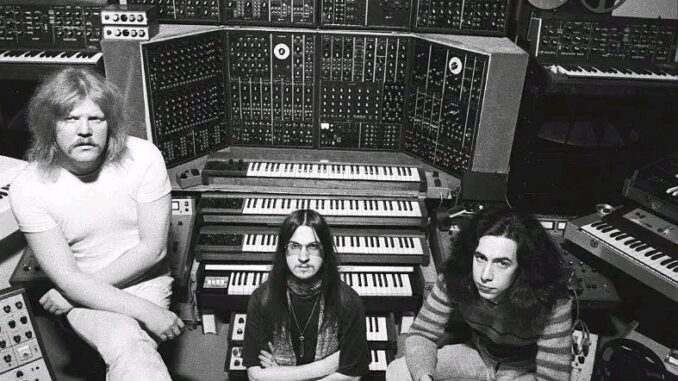
Tangerine Dream: Pioneers of Electronic and Krautrock Music
Tangerine Dream, founded in 1967 in Berlin by visionary musician Edgar Froese, stands as one of the most influential and pioneering bands in the history of electronic music and krautrock. Their innovative approach to sound, seamless blending of genres, and relentless exploration of emerging technologies have cemented their legacy as pioneers shaping the sonic landscape of the late 20th century and beyond.
**Origins and Formation**
In the late 1960s, Berlin was a fertile ground for experimental music, with artists pushing boundaries and exploring new sonic territories. Edgar Froese, inspired by the revolutionary musical ideas of the time, founded Tangerine Dream with the vision of creating immersive, cosmic soundscapes that transcended traditional musical structures. Initially, the band consisted of Froese and a rotating cast of collaborators, but the core vision remained focused on improvisation, electronic experimentation, and atmospheric compositions.
**Musical Style and Innovation**
Tangerine Dream’s sound is characterized by lush, layered textures, hypnotic rhythmic sequences, and the use of synthesizers and electronic instruments. Their music often evokes a sense of space and mysticism, drawing listeners into immersive auditory worlds. They pioneered the use of sequencers—synthesizers that generate repeating rhythmic and melodic patterns—which became a hallmark of their sound and influenced countless artists.
Their approach was highly experimental; they frequently combined live improvisation with studio techniques, creating evolving soundscapes that could stretch over extended durations. This method allowed them to craft immersive ambient pieces, film scores, and epic concept albums that told stories through sound.
**Contribution to Krautrock**
Krautrock, a genre rooted in Germany in the late 1960s and early 1970s, emphasized experimentalism, improvisation, and a rejection of mainstream rock conventions. Tangerine Dream was a pivotal figure in this movement, alongside bands like Kraftwerk, Can, and Faust. Their experimental ethos and innovative use of electronic instruments helped establish the genre’s distinctive sound—often characterized by hypnotic rhythms, spacey atmospheres, and avant-garde influences.
**Key Albums and Works**
Among Tangerine Dream’s most influential albums are:
– *Phaedra* (1974): Often considered their breakthrough, *Phaedra* introduced the revolutionary use of sequencers and synthesizers, creating a hypnotic and immersive sound. The album’s side-long title track exemplifies their ability to craft sprawling, atmospheric compositions that transport listeners to otherworldly realms.
– *Rubycon* (1975): Continuing their exploration of electronic textures, *Rubycon* features layered synthesizer melodies, rhythmic cycles, and a meditative quality that became emblematic of their style.
– *Zeit* (1972): Marking their early experimental phase, *Zeit* is a dense, improvisational album that captures their raw, cosmic sound.
– *Tangram* (1980): Demonstrating their versatility, *Tangram* incorporates more structured compositions and a broader range of sounds, including collaborations with other artists.
– *Sorcerer* (1977): The soundtrack for William Friedkin’s film *Sorcerer*, showcasing their ability to create cinematic atmospheres that enhance visual storytelling.
**Technological Innovations**
Tangerine Dream’s pioneering use of synthesizers, sequencers, and tape manipulation revolutionized electronic music. Froese and his collaborators were among the first to exploit these technologies to craft evolving soundscapes, often improvising live in concert. Their experimentation with modular synthesizers, such as the Moog, and later digital instruments, allowed for complex layering and dynamic textures.
They also embraced tape loops and delay effects, which contributed to their surreal, spacey aesthetic. Their technical innovations influenced not only the development of ambient and electronic music but also the broader use of synthesizers in popular music.
**Soundtracks and Film Scores**
Beyond studio albums, Tangerine Dream gained international recognition through their film scores. Their cinematic compositions are renowned for enhancing the emotional and atmospheric depth of films. Notable works include:
– *Sorcerer* (1977): A tense, atmospheric score that complements the film’s dark themes.
– *Thief* (1981): An electronic soundtrack that underscores the film’s noir aesthetic.
– *Risky Business* (1983): Featuring the hit “Love on a Real Train,” which became iconic in pop culture.
– *Firestarter* (1984): Providing a haunting, intense musical backdrop.
Their ability to craft evocative soundtracks further cemented their influence, bridging the gap between experimental electronic music and mainstream cinema.
**Evolution and Later Years**
Throughout the 1980s and 1990s, Tangerine Dream continued to evolve, experimenting with digital technology, incorporating more structured compositions, and collaborating with other artists. Froese’s leadership remained central, guiding the band through various lineup changes.
In later years, the band embraced digital production, and their live performances incorporated new technology, maintaining their reputation for immersive, transcendent concerts. Despite changes in personnel, the essence of their pioneering spirit persisted.
**Legacy and Influence**
Tangerine Dream’s impact extends far beyond their immediate genre. They influenced a wide array of artists across genres, including ambient, new age, film music, and even mainstream pop and rock. Their pioneering work with sequencers and synthesizers laid foundational groundwork for electronic dance music (EDM), ambient, and techno.
Their sound influenced artists like Brian Eno, Jean-Michel Jarre, and Vangelis. The band’s approach to creating immersive, atmospheric music has inspired countless musicians and composers who seek to evoke space, mysticism, and emotion through electronic means.
**Cultural Impact**
The band’s music became synonymous with the cosmic and futuristic aesthetic of the 1970s and 1980s. Their soundtracks often evoke a sense of adventure, exploration, and the unknown—echoing the era’s fascination with space exploration and technological progress.
Their influence extends into popular culture, where their tracks have been sampled, covered, and incorporated into films, television, and video games, ensuring their legacy endures.
**Conclusion**
Tangerine Dream’s pioneering spirit, technological innovation, and atmospheric soundscapes have left an indelible mark on the musical landscape. From their early experimental days in Berlin to their cinematic and ambient masterpieces, they have continually pushed the boundaries of what electronic music can achieve. Their legacy persists as a testament to the power of imagination, experimentation, and technological mastery in creating transcendent art that continues to inspire new generations of musicians and listeners alike.
Leave a Reply